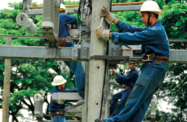The private sector is accelerating efforts to meet rising energy demand in the Philippines, with liquefied natural gas (LNG) import and processing capacity being fast-tracked as domestic supplies dwindle.

In January Energy World Corporation (EWC) announced it had been given final approval by the Department of Energy (DoE) under their new regulations to build the country’s first LNG import terminal and regasification facility, which is under construction on Pagbilao Grande island in Quezon.
The Australia-headquartered company – which also operates in its home market and Indonesia – has stated that the terminal, which is expected to be operational by March 2020, will have an import capacity of 3m tonnes per annum (tpa), providing up to 3000 MW of generation capacity.
Along with the terminal, EWC has approval to develop a 650-MW gas-fired power plant next to the facility, with the import terminal set to supply both the needs of the new power station and those of third-party clients.
“There is a great opportunity for LNG energy production given the growing electricity demand in the Philippines,” Graham Elliott, country manager of EWC, told OBG. “Given the low production cost, LNG-generated electricity would be competitive with any other energy source and can be less expensive than coal.”
This major investment project opens a path for other energy companies in an expanding market, though early arrivals will likely gain a competitive advantage.
Rising energy demand and falling gas supply spur LNG investment
The need to boost imports and regasification capacity is becoming increasingly urgent with the rapid depletion of the Malampaya gas field.
The field currently supplies three gas-fired power stations in Luzon, which have a combined capacity of 2700 MW, 30% of the energy requirements of the Philippines’ most populous island.
However, reserves are declining rapidly and full-scale production is projected to end by 2024, with the wells set to be depleted by 2029 at the latest.
LNG imports will be needed to bridge the gap between supply and demand unless significant new deposits can be identified and brought on-line over the next five years.
This shortfall is set to increase as Philippine energy requirements rise over the coming decades. While installed generation capacity stands at 23,000 MW, the DoE estimates the country will need to deploy an additional 44,800 MW by 2040.
While the government is looking for renewable resources to account for 20,000 MW of this new capacity – and has expressed interest in developing nuclear power – LNG is likely to meet much of the new demand.
LNG project in Batangas to come on-line
At least some of that LNG supply will come from two other projects in the pipeline.
In January the DoE granted permission to Tanglawan Philippines LNG to develop a 2.2m-tpa LNG terminal and processing facility in the province of Batangas.
The company – which is a joint venture between domestic firm Phoenix Petroleum and the Chinese state-owned enterprise China National Offshore Oil Corporation – plans to commence construction this year, with commercial operations to begin at the $686m regasification plant in 2023.
As part of the project, Tanglawan Philippines LNG also plans to develop a 2000-MW gas-fired power station at an estimated cost of $1.3bn.
The state-run Philippine National Oil Company (PNOC) has expressed interest in joining the venture, with Alfonso Cusi, secretary of energy and chairman of PNOC, announcing in January that the parties had agreed in principle to the state-owned firm taking a stake in the development of the facility.
Further LNG import and processing facility
While the EWC and Tanglawan LNG projects were both endorsed by the DoE, another company has also applied for approval to construct an LNG facility.
In December domestic energy firm First Gen announced that it had entered into a joint development agreement with Japan-headquartered Tokyo Gas. First Gen had applied for a notice to proceed permit with the DoE for the green light to build a LNG terminal and regasification facility in Batangas City.
If given the go-ahead, the prospective project would be used to provide feedstock to First Gen’s four existing gas-fired power stations as well as to third parties.
As the Philippines moves to scale back the use of coal in its energy mix – which currently accounts for 50% of power generation – the input of LNG can be expected to increase, improving cost efficiency and reducing carbon emissions, according to Jon Russell, executive vice-president of First Gen.
“Gas is among the most competitive energy sources, especially if coal prices keep rising,” Russell told OBG. “The capital cost of installing an LNG plant, or a regular gas-fired plant, is three times cheaper than coal and significantly less damaging for the environment. In addition, with a future of more renewable energy power generation, gas-fired plants are the perfect partner as their ability to ramp-up and ramp-down complements the intermittent nature of renewables.”


